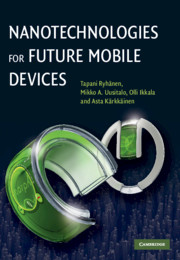Book contents
- Frontmatter
- Contents
- List of contributors
- Preface
- 1 When everything is connected
- 2 On the possible developments for the structural materials relevant for future mobile devices
- 3 Energy and power
- 4 Computing and information storage solutions
- 5 Sensing, actuation, and interaction
- 6 Future of Radio and Communication
- 7 Flat panel displays
- 8 Manufacturing and open innovation
- 9 Seeing beyond the hype: what the Internet teaches us about the development of nanotechnology
- 10 Conclusions
- Index
10 - Conclusions
Published online by Cambridge University Press: 05 July 2014
- Frontmatter
- Contents
- List of contributors
- Preface
- 1 When everything is connected
- 2 On the possible developments for the structural materials relevant for future mobile devices
- 3 Energy and power
- 4 Computing and information storage solutions
- 5 Sensing, actuation, and interaction
- 6 Future of Radio and Communication
- 7 Flat panel displays
- 8 Manufacturing and open innovation
- 9 Seeing beyond the hype: what the Internet teaches us about the development of nanotechnology
- 10 Conclusions
- Index
Summary
We have discussed mobile communication, the Internet, and nanotechnologies as a toolkit for building the next phase of human progress. All these technologies can be understood to have profound capabilities that will shape our economies and our everyday lives. Our specific focus has been on studying the impact of nanotechnologies on mobile devices and services. Nanotechnologies enable integration of new functionality into mobile devices and thus the creation of new digital services. We have also seen that nanotechnologies can be used to link digital information to various processes in the physical world, including social networks and urban infrastructures.
This book has discussed various key technologies: materials, energy, computing, sensing, actuation, displays, and wireless communication. We have identified potential technology disruptions for all these areas. Most nanotechnologies are still in the early stages of research, and the engineering effort to commercialize them will take at least 10-20 years. Their impact will be gradual: new nanomaterials will at first complement traditional solutions and improve the characteristics of various technologies. The disruptive nature of nanotechnologies will finally manifest itself by changes to our ways of interacting with the physical world, our environment, and our bodies.
The capability to tailor the properties of bulk and surface materials will affect our future handheld and wearable devices making them more robust, intelligent, transformable, sensitive, and environmentally friendly with functionalities embedded in these new materials themselves. Instead of using materials just to create functional devices, the materials will have meaningful integrated functions and even multiple simultaneous functions.
Information
- Type
- Chapter
- Information
- Nanotechnologies for Future Mobile Devices , pp. 258 - 261Publisher: Cambridge University PressPrint publication year: 2010
